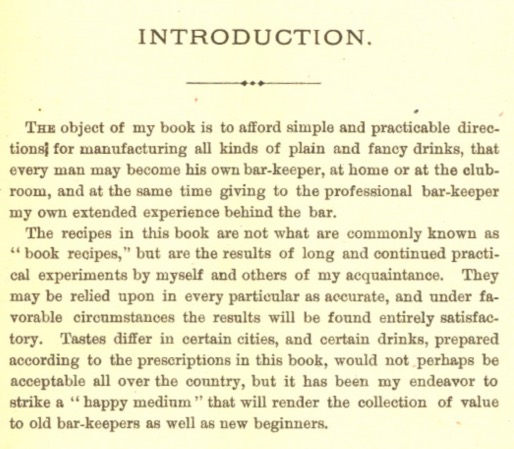Yesterday, I wrapped up an initial foray into the convoluted situation around this slim volume:
I say “initial” because there are many questions about it I still cannot answer, most obviously, who wrote it and how it came about. It’s a resolutely anonymous project. Notably, the introduction begins,
This book is not placed before the public as a “bar-tender’s guide,” nor is it a list of all the fancy combinations of various liquors invented to advertise certain establishments, or for imposing on the ignorant. It is a recipe book compiled for private use.
This is one of the earliest, and maybe the first, cocktail book intended for home use.
The book was published in 1900 by L. C. Page & Company, the firm of Louis Coues Page, who found enough success to co-own the Boston Braves circa 1910. It’s possible this book was somehow a product of his editorial staff—it seemed he did publish books on a wide range of general interest topics.
You will find a PDF of a 1901 printing of the 1900 edition on the EUVS site.
In 1902, a significantly different version was published in London by John Macqueen. (You will also find a PDF of this edition on the EUVS site.) This version stripped out a couple dozen recipes from the original. These omissions may have been an attempt to tailor the book for the English market—many of the drinks removed required applejack and calisaya. Other omissions, such as the silver fizz may have been arbitrary. Three additions were made:
- a full page recipe for a West India Swizzle (a swizzle with a large dose of Angostura Bitters)
- the “Digester”, a sling made with Angostura Bitters
- a full page discussing bottled cocktails from an outfit named Crane’s
In 1913, L. C. Page & Company issued a New Revised Edition that removed about seven recipes from its 1900 edition, and added about thirty eight recipes that were a strange mixture of new (Bronx, Dubonnet, Sazerac, Jack Rose, Clover Club, Ramos Fizz, Stinger) and old (Blue Blazer, Morning Glory Fizz, Planter’s Punch, etc.) To my knowledge, no English version of this edition transpired.
In 1925, L. C. Page & Company issued yet another New Revised Edition, which was exactly identical to the 1913 edition, except for an entire section inserted in the middle under the title “Some Recent Favorites”. This new section added the Daiquiri, Bacardi Cocktail, and a dozen or so obscurities.
In 1926, the 1925 edition was published in London, verbatim, by John Hamilton, Ltd. (The West India Swizzle and Digester from the 1902 edition are not included.)
Finally, in 1933, L. C. Page reprinted the 1925 edition, verbatim, as the “Repeal Edition”.
The upshot is that there seems to be only three true editions of this book: the 1900, the 1913 and the 1925, all originating in Boston. The peculiarities of the 1902 version for England make for an interesting footnote.

